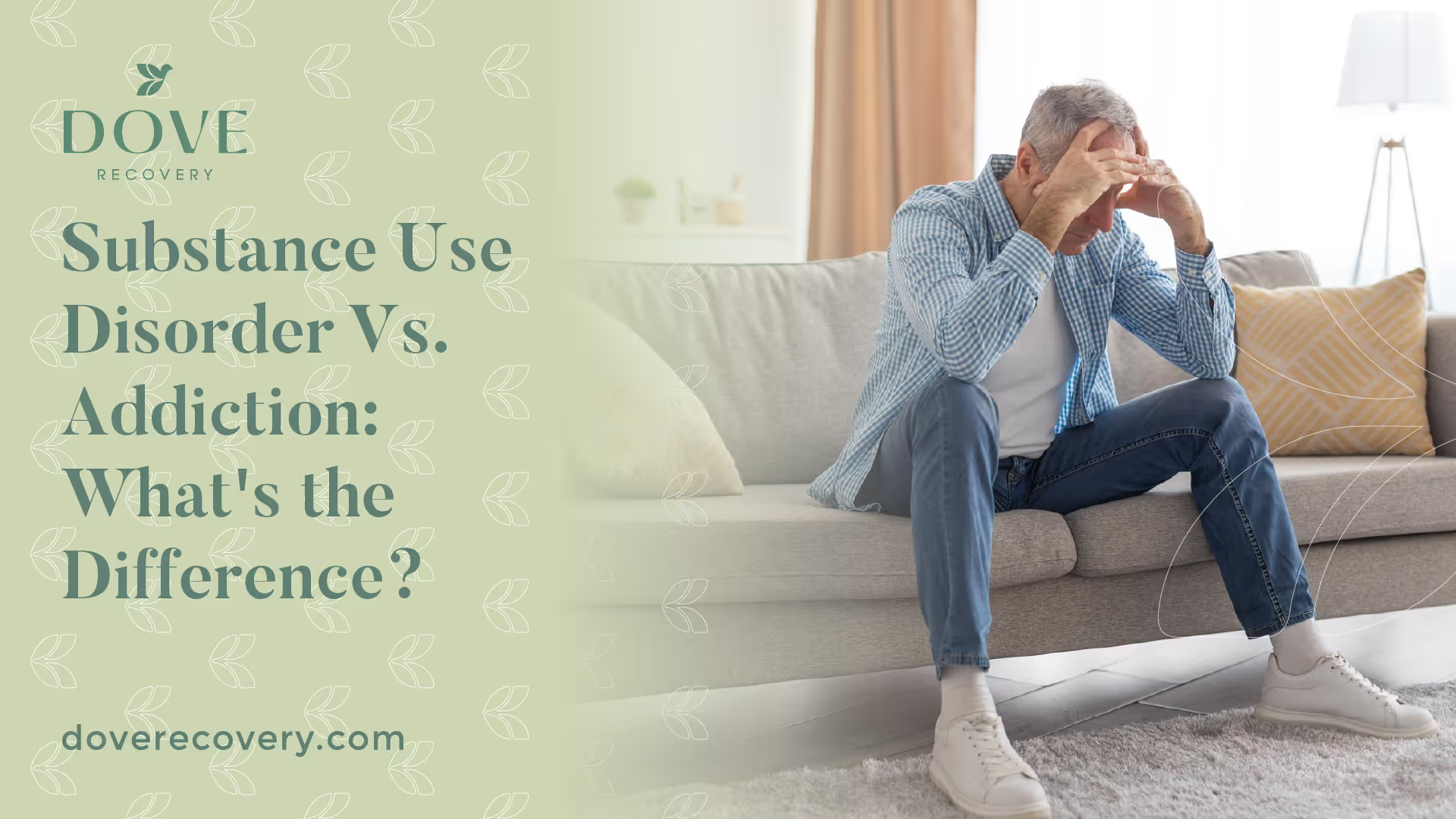Substance Use Disorder Vs. Addiction: What's the Difference?

Substance Use Disorder
If you're like most people, you probably use the terms "substance use disorder" and "addiction" interchangeably. While both terms refer to a person's unhealthy relationship with drugs or alcohol, there are some key differences between the two.

Substance use disorder (SUD) is a medical diagnosis used to describe a pattern of substance use that causes significant impairment or distress. The fifth edition of the Diagnostic and Statistical Manual of Mental Disorders (DSM-5) lists 11 criteria that can be used to diagnose SUD. These include:
- Taking the substance in larger amounts or for longer than intended
- Wanting to cut down or stop using the substance but not being able to
- Spending a lot of time getting, using, or recovering from the substance
- Craving or feeling a strong desire or urge to use the substance
- Failing to fulfill major obligations at work, school, or home because of substance use
- Continuing to use the substance despite persistent or recurrent social or interpersonal problems caused or exacerbated by the effects of the substance
- Giving up or reducing important social, occupational, or recreational activities because of substance use
- Using the substance in situations where it is physically hazardous
- Continuing to use the substance despite knowing that it is causing or worsening a physical or psychological problem
- Developing tolerance, which means needing more of the substance to get the desired effect
- Experiencing withdrawal symptoms when not using the substance or using it to relieve or avoid withdrawal symptoms
According to the National Survey on Drug Use and Health (NSDUH), 19.7 million American adults had SUD in 2017. SUD can range from mild to severe, depending on the number of criteria met.
Addiction
Addiction is a complex brain disease that is characterized by compulsive drug seeking and use despite harmful consequences. Addiction is not a formal diagnosis, but it is often used interchangeably with "substance use disorder."
The Diagnostic and Statistical Manual of Mental Disorders (DSM) does not use the term "addiction" to describe a disorder. Instead, it uses "substance use disorder." The DSM-5 suggests that the term "addiction" should be reserved for cases where the individual is compulsively drug-seeking and using despite negative consequences.
Addiction is characterized by a pattern of compulsive drug use, even when the individual knows that the drug use is causing problems in their life. Addiction goes beyond physical dependence on a substance and can have far-reaching consequences, including problems with relationships, finances, and legal issues.
The Key Differences
Substance use disorder (SUD) and addiction are related terms, but they have different meanings. Here are some key points to help distinguish between the two:
- SUD is a medical diagnosis that describes a range of substance-related problems, from mild to severe. It refers to a pattern of drug use that leads to significant impairment or distress, as manifested by at least two of the following: tolerance, withdrawal, using more than intended, inability to cut down, giving up social or recreational activities, and continued use despite negative consequences.
- Addiction is not a formal diagnosis in the medical community. Instead, it is a lay term that is often used to describe a severe form of SUD characterized by compulsive drug-seeking and use despite negative consequences. Addiction involves a loss of control over drug use and a strong craving for the drug that can persist even after discontinuing use.
In summary, while both SUD and addiction involve problematic drug use, addiction describes a more severe form of SUD that involves compulsive drug-seeking and use despite harm.
Types of Substance Use Disorders
There are several types of substance use disorders that can be diagnosed based on the specific symptoms and patterns of drug use. Some of the most common types include:
- Alcohol use disorder: This type of SUD involves problematic alcohol use, such as drinking more than intended or being unable to stop drinking despite negative consequences.
- Opioid use disorder: This SUD involves the misuse of prescription painkillers or heroin, leading to physical dependence, tolerance, and withdrawal symptoms.
- Stimulant use disorder: This type of SUD involves the misuse of drugs like cocaine or methamphetamine, which can lead to a range of health problems and negative consequences.
- Cannabis use disorder: This SUD involves problematic marijuana use, such as using more than intended or continuing to use despite negative consequences.
- Hallucinogen use disorder: This type of SUD involves the abuse of drugs like LSD or psilocybin mushrooms, which can cause intense hallucinations and other psychological effects.
It's important to note that these are just a few examples of the different types of substance use disorders that exist. Each type has its own unique set of symptoms and treatment options. If you think you or someone you know may have a substance use disorder, it's important to seek help from a qualified healthcare provider.
Risk Factors for Developing Substance Use Disorder
While anyone can develop a substance use disorder, certain factors can increase the likelihood of developing one. Here are some common risk factors:
- Genetics: Genetics play a role in the development of substance use disorders. Individuals with a family history of addiction are more likely to develop an addiction themselves.
- Mental health conditions: Mental health conditions such as depression, anxiety, and post-traumatic stress disorder (PTSD) can increase the risk of developing a substance use disorder.
- Early exposure to drugs or alcohol: Individuals who start using drugs or alcohol at a young age are more likely to develop a substance use disorder later in life.
- Trauma: Traumatic experiences such as physical or sexual abuse can increase the risk of developing a substance use disorder.
- Social environment: The social environment can also play a role in the development of substance use disorders. Individuals who have friends or family members who use drugs or alcohol are more likely to develop an addiction themselves.
It's important to note that while these factors can increase the risk of developing a substance use disorder, they do not guarantee that someone will develop one. Additionally, other factors not listed here may also contribute to the development of an addiction. If you're concerned about your own drug or alcohol use or that of someone you know, it's important to seek help from a qualified healthcare provider.
Treatment Options for Substance Use Disorder
Substance use disorder is a treatable condition, and there are several options available to help individuals recover from addiction. The most effective treatment plans often involve a combination of therapy, medication, and support groups.
Therapy
Therapy can be an effective tool in treating substance use disorder. There are several types of therapy that may be used, including:
- Cognitive-behavioral therapy (CBT): CBT helps individuals identify and change negative patterns of thought and behavior that contribute to substance use.
- Motivational interviewing (MI): MI is a client-centered counseling style that helps individuals identify their own reasons for wanting to change their behavior.
- Family therapy: Family therapy involves working with the individual's family members to address any issues that may be contributing to the addiction.
Medication
Medication can also be an important part of treating substance use disorder. Some medications used to treat addiction include:
- Methadone: Methadone is a medication used to treat opioid addiction by reducing withdrawal symptoms and cravings.
- Naltrexone: Naltrexone is a medication used to treat alcohol and opioid addiction by blocking the effects of these substances on the brain.
- Bupropion: Bupropion is a medication used to treat nicotine addiction by reducing cravings and withdrawal symptoms.
It's important to note that medication should only be used as part of a comprehensive treatment plan under the supervision of a qualified healthcare provider.
Support Groups
Support groups can also play an important role in treating substance use disorder. Some examples of support groups include:
- Alcoholics Anonymous (AA): AA is a 12-step program for individuals recovering from alcohol addiction.
- Narcotics Anonymous (NA): NA is a 12-step program for individuals recovering from drug addiction.
- SMART Recovery: SMART Recovery is a science-based program that uses cognitive-behavioral therapy techniques to help individuals recover from addiction.
Support groups provide individuals with a safe and supportive environment where they can connect with others who are also in recovery.
Reducing Stigma and Encouraging Help-Seeking
One of the biggest barriers to seeking help for addiction is the stigma that surrounds it. Many people with substance use disorders are hesitant to seek treatment because they fear being judged or stigmatized by others. However, reducing stigma and promoting a more compassionate view of addiction can help encourage individuals to seek the help they need.
There are several ways to reduce stigma surrounding addiction and encourage individuals to seek help:
1. Education
Education is one of the most effective ways to reduce stigma surrounding addiction. By increasing awareness and understanding of addiction as a disease, we can help break down stereotypes and myths about people with substance use disorders. This can be done through public campaigns, community events, and educational programs in schools and workplaces.
2. Language
The language we use when talking about addiction can also have an impact on how people perceive it. Using stigmatizing language like "junkie" or "addict" can reinforce negative stereotypes about people with substance use disorders. Instead, using person-first language like "person with a substance use disorder" or "person in recovery" can help promote a more compassionate view of addiction.
3. Support
Supporting individuals in recovery from addiction is another way to reduce stigma and encourage help-seeking behavior. This can involve volunteering at local treatment centers or recovery groups, advocating for policies that support people in recovery, or simply offering a listening ear to someone who is struggling with addiction.
4. Role Models
Having visible role models who have successfully overcome addiction can also be an effective way to reduce stigma and encourage others to seek help. This includes celebrities, athletes, and other public figures who have shared their stories of recovery from addiction.
By taking these steps, we can work towards reducing the stigma surrounding addiction and creating a more supportive environment for those who are struggling with substance use disorders.
Conclusion
In conclusion, while the terms "substance use disorder" and "addiction" are often used interchangeably, they are not the same thing. Substance use disorder is a medical diagnosis that can range from mild to severe, and addiction is a term used to describe a severe form of SUD characterized by compulsive drug-seeking and use despite negative consequences.
If you or someone you know is struggling with substance use, it's important to seek professional help. There are many treatment options available, and recovery is possible.
Sources:
- National Institute on Drug Abuse: https://www.drugabuse.gov/publications/drugfacts/understanding-drug-use-addiction
- Substance Abuse and Mental Health Services Administration: https://www.samhsa.gov/data/report/2017-nsduh-annual-national-report
- https://www.psychiatry.org/patients-families/addiction-substance-use-disorders
